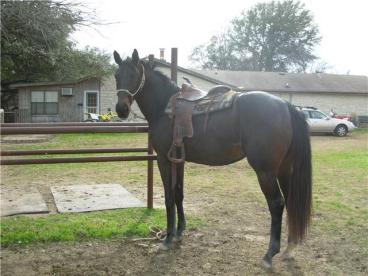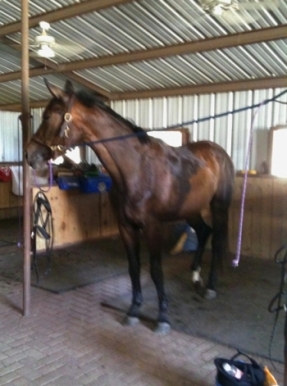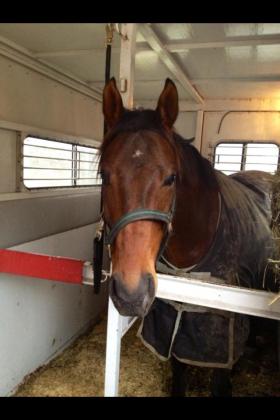As promised on Monday, I wanted to circle back and discuss “The Tree of Knowledge” that Presto spent many hours tied to last weekend.

The practice of tying horses out alone is an old one. The cowboy set in particular has been doing this for a long time. Sometimes they use a telephone pole set into the ground, sometimes it’s a special metal pole high tie, sometimes you’ll see someone sling the rope over the rafter of an indoor, and sometimes, if you’ve got a good tree, you can use that too.

The important part is that the horse is tied to a point that is high – above it’s head. This way they can move around however they want and not become entangled, but they also can’t get any leverage to really hurt themselves if they go to pull back. A horse that’s tied at body level can break just about any tie apparatus and do a lot of damage to it’s neck/back, just because the force it can exert at that angle is tremendous. A horse that’s tied to something well above it’s head can’t get much leverage at all.
The point of it is not to torture the horse by leaving it tied for hours, it’s to teach the horse a) to tie reliably, b) patience, c) how to self-soothe.

To me it’s extremely important that any of my horses be able to tie reliably, and be able to be left unattended for at least brief periods of time. This is a skill that, for my lifestyle, is absolutely vital. A horse that can’t do this will eventually get himself or his human into trouble one day, and likely hurt himself in the process. Teaching a horse to tie reliably, from a young age, is doing that horse a real service for the rest of his life, IMO.
It’s also extremely important that a horse learns that once he’s tied, he may as well just stand there and chill. As soon as they’re tied they should put it in park, take a breath, and wait for something else to happen, whenever that may be. Not on their schedule, but on mine. No pawing, no dancing back and forth, no pulling back when they decide they’re done waiting. And more importantly, no worrying about what else might be going on around them. Rudeness and tantrums get you nowhere.
They also learn that no matter what happens or how they act, no one is going to come get them. They might be stressed out about it at first, but over time they figure out that their shenanigans don’t work, so they may as well just relax. That’s self-soothing. They’re not getting their relief from another horse, or from a human… they’re using their own brains to realize that they’re okay by themselves. That’s a skill that goes a long way in getting a horse to be more confident in all aspects of it’s life.

I was first introduced to this concept when Sadie went off to the cowboy for breaking. She was NOT reliable about standing tied, and had learned that she could sit back and break just about anything. It really stemmed from the fact that she was just unsure of herself in general and lacked confidence, especially when she was alone. When she got to the breaker she spent many hours tied to his patience tree, especially those first couple weeks. She pawed, she paced, she had temper tantrums, she attacked the tree, she tried to pull back, she tried to lay down, and made a general menace of herself. And you know what happened?
Nothing.
No matter what she did, she was still standing there at that tree by herself. It didn’t take long before he could take her out to the tree and she would just stand there quietly in the shade until he came back, content to take a nap. She didn’t just learn how to tie or how to be patient, she learned how to simply exist within herself, not relying on outside comfort. The lessons went a lot deeper than tying. I made a mistake by not teaching her those things earlier in her life, and I’m not going to repeat it with her son.

I am a big fan of the concept of patience trees, or as I like to call it, “The Tree of Knowledge”. Because it’s not really just about patience at all.
I still come across people that think leaving a horse standing tied for hours is inhumane. If the horse is standing with it’s head tied high (ie no slack in the rope, forcing the horse to hold it’s head higher than it normally would), or if the horse is left all day with no water, or if it’s unbearably hot and there’s no shade – then I would agree. But if the horse has no real reason to be physically uncomfortable, then he has no reason to be upset about being tied. He’s more comfortable standing there than he would be standing for hours in a trailer, yet we don’t think trailering is inhumane (ok, I’m sure someone out there does…).

Presto spent about 3 hours each day tied to the tree. At first he was quite mad. He’s pretty solid about being tied so I never saw him try to sit back, but he has not yet learned that the world doesn’t revolve around him and boy did he pace and paw. Eventually the behaviors started to lessen, and he began to accept his fate. He didn’t perfect his patience skills just in those two days, but I think he definitely learned a little bit about how things don’t always operate on his terms. The barn owner built me a high tie in the indoor at home that he will soon become well acquainted with, but I wanted him to log his first few hours on the tree – my favorite place to tie.
I also would not have put him out there if he hadn’t learned some basic ground rules beforehand. First and foremost, he had to know how to give to pressure. I don’t think you should ever tie a horse (anywhere, under any circumstances) that doesn’t understand the very basics of yielding to pressure. He’s also been required to stand tied for decent periods of time with me in attendance, so standing still isn’t a foreign concept either. We built up to it in a way that I felt was fair to him. The only thing different was that this time he had to do it alone.

Some people don’t agree with this approach, and that’s ok. Different strokes for different folks. But for me it’s been a really valuable method that has made a big difference in my horses, and that’s why I do it. At the end of the day, it’s my responsibility to make the horse into a solid citizen, and that’s a responsibility that I don’t take lightly at all, especially considering I’m the entire reason this horse is even on this planet in the first place. I’ll do the best I can with the lessons I’ve learned from past mistakes, and hope that he learns what he needs in order to have the best possible life, no matter what.

PREACH! I love my tree. Everybody spends at least a little time on it at some point in their life. Put my retired rodeo horse on the Tree of Knowledge just the other day when I separated him from his girlfriend to trim his feet and he forgot that he’s a hundred and used to have manners. Walking out to the tree was a shitshow of screaming and rudeness but thirty minutes or so on the tree and his brain had been reinstalled without me having to be anywhere near his rude, arrogant self.
LikeLiked by 1 person
Henry has spent some time on The Tree too, for those same reasons. 😂🙄
LikeLiked by 1 person
Bast definitely needs to find a tree. He just recently became introduced to the idea that not all ropes break and sometimes you can’t just yank real hard and leave. It was a good lesson. Now that he understands that, and gives up, I think he’s ready to learn some by himself.
LikeLike
I swear every young horse needs a tree.
LikeLike
Oddly I don’t have any experience with the tree of knowledge (having grown up amongst real cowboys!). Does it matter what kind of halter/lead you use? My 11 TB is awful about tying. He will stand in cross ties, but can’t be tied to anything else (he sets back) and it is maddening so I think tree of knowledge would be really good for him. And I have a LOT of trees.
LikeLike
Rope halter works best.
LikeLiked by 1 person
Appending, from ridiculous experience with a certain fat bay mare of mine, that the rope halter needs to be well-fitted and the knots need to be pulled tight into themselves. Otherwise, certain clever horses may figure out that if they work at it, they can stretch rope halters to the point where rope tension + dropping one’s nose + dropping one’s head = FREEDOM!!
LikeLike
Yes, the halter definitely must fit correctly and be tied correctly for it to work.
LikeLike
The knots are really the kicker for me. I had a couple that were well-fitted otherwise, but evidently the knots were not fully tightened down. They… are now draft-sized. My horse… is not. lol
LikeLike
👏👏 love this post. My show horses (minus Cinna, who is still working on this concept, since I lack a safe “tree” right now) can all be tied to my trailer with hay and water and left alone (relatively speaking, I don’t mean I leave the property or anything haha). I still remember a dressage show where I was showing multiple classes with a 5 hour break in between, and the organizer kept offering me stalls. I don’t think she believed me that it wouldn’t be a problem to leave one tied while I showed the other. No issues though 🤷
LikeLike
Such an important skill for a horse to have!
LikeLike
I’ve seen this concept used before and I definitely think it’s useful! It has a lot of applications for use too. From this perspective at least it seems like you are well on your way to making sure Presto will be a solid equine citizen who will be able to adapt to lots of new circumstances wherever life takes him.
LikeLike
This is the best description of the how, the why, and the concept of the Patience Pole, or Tree of Knowledge, that I’ve ever read or heard.
LikeLiked by 1 person
What type of long line do you recommend for a mature 1200 lb TB who does have that preliminary introduction? He stands tied well for about 30 minutes in the barn, and understands to give to pressure. But he’s not ready to stand tied to a trailer, by himself, at a horse show. He needs to be. 🙂
LikeLiked by 1 person
I don’t think it really matters, as long as you tie a proper knot (one that the horse cannot pull tight).
LikeLike
It was a good thing I wasn’t Amber’s owner when she was first tied because I would’ve given in and it would have been bad lol. I didn’t know any better at the time, but man she was MAD MAD MAD about being tied. She was in a stall and couldn’t go far, but she was tied high and managed to break one halter, got her foot caught in the nose portion of a rope halter, and then snapped a connector that connected 2 chains together. There were people around to cut her loose, and they always had an eye on her so she was safe, but you know what? That horse ties beautifully, all the time. I never have to worry about that with her, so I’m so glad there were people that knew how to stick with it lol. Any horse I get next will certainly have the same thing done!
LikeLike
Stalls are tougher, since the walls generally aren’t quite high enough to take away the leverage. It does work though, as you’ve noticed. It’s good that she’s so solid about it now.
LikeLike
Love my patience tree’s! I have one up by the barn and another down by the arena. All mine have spent quality time on them and it has paid off with good solid tying citizens. At this point they are less for patience and more for – wait here while I do something I forgot to do before I got you all tacked up – trees. Still, very useful!
LikeLiked by 1 person
My favorite thing about tying them this way is like you mentioned, it’s all on them. No person is doing anything to them directly and they get to choose when to give in or keep fighting. There’s no outside force fighting back.
I don’t know much at all about these earliest years of training, but from what I do know, Presto is getting a ton more education early on than most babies I’ve encountered. He takes to it so readily, I’m sure that it will carry over once he’s a big kid. You’re doing such a great job with him.
LikeLike
Exactly. That’s exactly it. Sometimes the best and safest way to teach a horse anything is to let them teach themselves.
LikeLike
May probably needs a tree… When I got her, she was a complete bully on the ground. Now, she ground ties really reliably, but she won’t “hard tie” to anything. If she feels trapped, she will take the whole damn barn with her to get way. Maybe I can find her a tree lol.
LikeLike
June needs a tree so badly. SO BADLY. She’s fine when I am around, but once I am not paying attention to her it’s paw city. We’re working on finding a safe place to high tie her. Thanks for the great explanation of the how and why!
LikeLike
That’s Presto too. Fine when I’m there, insecure when I’m not. He’ll learn. He might spent many hours tied out, but he’ll learn. 😂
LikeLike
is this training that is no longer necessary after a certain point? Or are refreshers important all through life?
LikeLike
In my experience, it really depends on the horse. Most of them learn patience and self-soothing and retain it reasonably well. Others (usually arrogant geldings I’ve found) need refreshers from time to time. My 6 year old spent maybe three sessions on the tree as a 2 year old and has never gone back. My retired 20 year old, been around the world in a horse trailer twice, needs refreshers from time to time.
LikeLike
The first horse I bought as an adult didn’t tie. He was 9, I was coming back into horses after a long time away and I was never able to get him over it. I tried a lot of different methods advised by a lot of different people, but that horse broke cross ties, halters, a hitching post (that I was told was unbreakable), as well as 3 out of 4 tie rings on my trailer. Definitely learned my lesson and that was the second thing I hammered into P (after self-loading on the trailer). Because a horse that wont tie is a nightmare. Cool that your BO is building you a place for Presto to practice
LikeLike
I am fairly certain my horse spent a lot of time with the tree of knowledge. He was western broke and has now turned into a hunter. And every time I go to a show by myself I am grateful for this skill set. 🙂
LikeLike
Can I tie my children to the tree of knowledge? These are definitely skills the toddler needs to master.
LikeLike
Yes. 100% yes.
LikeLike
We are really grateful for your blog post. You will find a lot of approaches after visiting your post. I was exactly searching for. Thanks for such post and please keep it up. Great work. http://www.navigationplus.com/navigue/art-tele.php
LikeLike
will tying him to the tree help to keep him from pawing in the trailer ???? lol
LikeLike
What a nice article! I had a mare about 10 years ago who loved to break out of anything I tied her to by just leaning baaaack and snapping that halter. I could have used this on her!
LikeLike